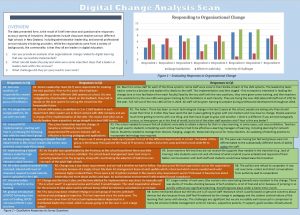
Interview Process
The interview subjects were asked to respond to three questions and rank the degree of difficulty associated with implementing the change on a scale of 1 – 10, with one representing a low degree of effectiveness and ten indicating a high degree. Question 1 was accompanied with the request to rank the change against the existing culture at the organisation, whereby 1 would indicate low impact on existing culture, and 10 indicating a high impact. Results of these rankings are seen in Figure 1.
Readiness for Change
Weiner (2009) argues that contextual factors have a significant bearing on an organisation’s change readiness, and that the culture can either dampen or heighten openness to change depending on whether the existing culture is supportive of the proposed change, or whether the change will necessitate a drastic cultural or operational shift. Respondents to the survey who identified organisational change as being more of a departure from the existing culture of the workplace reported stronger resistance to these changes, as reported by results from question 3. The discrepancy between significant cultural change and increased difficulty in mitigating this change can be linked to a failure to recognise the group organisational dynamic. The open systems view of organisational development identifies a need to recognise that change has to occur on a team level, and that ongoing change should be adaptable to revolutionary environments, thereby creating a culture of continuous learning (Al-Haddad & Kotnour, 2015). In the cases of respondents 4, 6, and 7 qualitative feedback reinforces a general frustration with the process of change due in large part to failure of participants to see the value of the change, and to varying degrees a failure in leadership to effectively implement a plan.
The Importance of Leadership and Planning
According to Bierch (2007), identifying a plan for organisational change, and involving all key stakeholders in the creation and implementation of the plan are essential. Survey results where leadership was ranked more effective than either the degree of cultural change, or the severity of challenges, saw not only higher satisfaction rates with leadership strategies, but also decreased severity of challenges faced (Respondents 1,2,5, and 8). This, coupled with survey comments, suggests that in these instances the organisations successfully employed change efficacy strategies. Drawing on social cognitive theories, Weiner (2009), notes that change implementation relies on knowing necessary courses of action, ensuring the necessary resources are in place, identifying the demands on the organisation, and determining whether the desired change can be accomplished within the allotted timeframe. Survey respondents who noted low leadership readiness (question 2), and high degree of challenges (question 3), commented in their responses that direction, resource and time management were not well managed. In the case of respondents 6 and 7, the professional service industry providers, reported high degrees of resistance to any kind of institutional change.
Link to Change Theory and Concluding Remarks
While no specific change model was asked to be identified by the respondents, in the educational settings reflected in these survey results, Kotter’s (1996) Eight Step Model, serves as a rough guideline to process of change reported. The first step in Kotter’s model is removing creating a sense of urgency. This is achieved by removing complacency. In the instances where a clear leadership strategy was lacking, and challenges were great, this first step was ignored. Similarly, the types of challenges identified by the more successful instances were relating to, as respondent 2 put it “dealing with the haters”, or those who did not see the point in changing. The more successful implementers of change recognised the importance of creating a guiding coalition. Respondents 1-3 and 8, were from the same institution, at various stages of change integration, and all cited an effective leadership team, with the senior-most person (Respondent 8) noting that success was dependent on “a distributed leadership model”. Developing and communicating the vision were also noted by the more successful respondents, while at the same time being omitted by respondents in the less successful institutions.
Following through the remaining steps of Kotter’s Eight Step model, culminates with creating a new culture of change. This proves especially challenging when dealing with e-based learning initiatives, a sector that is constantly changing. As Udas (2008) notes: “there are expectations that we will instigate change to accommodate a perceived future, even if that future cannot readily be defined” [blog post]. Bierch (2007) notes that effective organisational management is key, and attempts to deviate to greatly from existing culture will create further implementation challenges going forward. Here again respondents who rated cultural change low, also rated challenges to change low, and leadership infrastructure and vision high, proving the effectiveness of a theoretical framework like Kotter’s (1996) eight step approach in effectively managing institutional change.
References
Al-Haddad, S., & Kotnour, T. (2015). Integrating the organizational change literature: a model for successful change. Journal of Organizational Change Management, 28(2), 234-262.
Biech, E. (2007). Models for change. In: Thriving through change: A leader’s practical guide to change mastery. American Society for Training and Development.
Kotter, J. (1996). Leading Change. Boston, MA: Harvard Business Review Press.
Udas, K. (2008, June 30). Distributed learning environments and OER: the change management challenge. [blog post]. Retrieved from: https://web.archive.org/web/20160309200155/http:/mfeldstein.com/distributed-learning-environments-and-oer-the-change-management-challenge/
Weiner, B. J. (2009). A theory of organizational readiness for change. Implementation science, 4(1), 67.